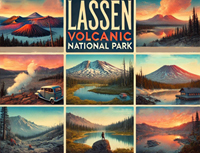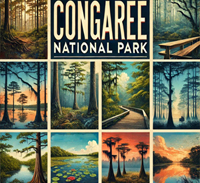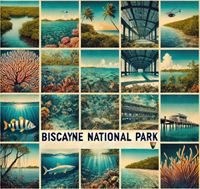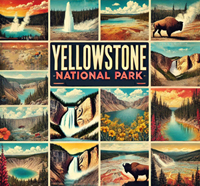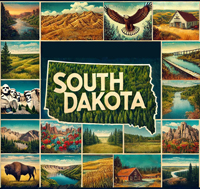

Embark on a journey curated by seasoned explorers William and Hui Cha Stanek, who have spent decades immersing themselves in the diverse landscapes of North America. These itineraries are more than just travel plans - they are thoughtfully crafted adventures designed to help you connect with the natural world, discover hidden gems, and create lasting memories.
National Parks Index | US Itineraries Index | American Roadtrips Index

Bring home a Bugville Critters book and watch as your child's love for reading and learning grows with every page. Hand-painted illustrations bring the heartwarming stories to life. Ask your librarian to add Bugville Critters to the library's digital collection today!
Discover William Stanek's Exclusive Art Collection
Explore and purchase the stunning art featured on this site. Own a piece of William Stanek's unique and captivating artwork today!
(February 22, 2025) Exploring Rocky Mountain National Park and Arapaho National Forest: Colorado's Majestic Wilderness
Introduction: A 2-Day Journey Through Colorado's High Country
There's something undeniably powerful about the Colorado high country. It's not just the elevation, though being more than a mile above sea level certainly adds to the experience. It's the way the air feels crisper, the way the light seems a little brighter, and the way the mountains dominate the horizon, reminding you of the immense power and beauty of nature. Hui Cha and I have always been drawn to these mountains – the Rockies have a way of grounding us, of putting life's challenges into perspective.
Our journey began on a crisp autumn morning, the kind where the sky is impossibly blue and the first hints of snow dust the peaks. We had set out early, eager to explore Rocky Mountain National Park and Arapaho National Forest, two of Colorado's most stunning natural areas. The drive from our home in Colorado Springs took us through some of the state's most beautiful scenery – rolling foothills giving way to towering peaks, the trees cloaked in their autumn finery of golds and reds.
As we neared the entrance to Rocky Mountain National Park, the excitement built. This park, with its rugged mountains, alpine lakes, and abundant wildlife, holds a special place in our hearts. It's where we've shared countless adventures, where we've celebrated milestones, and where we've found solace in the beauty of the natural world. But this trip was about more than just revisiting old favorites – it was about deepening our connection to this incredible landscape, exploring new trails, and discovering the quiet corners of the park that we had yet to experience.
And then there was Arapaho National Forest, a vast expanse of wilderness that stretches from the Continental Divide to the outskirts of Denver. While Rocky Mountain National Park draws visitors from around the world, Arapaho National Forest offers a different kind of experience – a more solitary, more intimate connection with the land. Here, the trails are less traveled, the mountains no less majestic, and the sense of wilderness even more profound.
Join us as we take you on a journey through these two remarkable places – Rocky Mountain National Park and Arapaho National Forest. We'll share our stories, tips, and insights to help you create your own unforgettable experiences in Colorado's majestic wilderness.
Day 1: Immersed in the Beauty of Rocky Mountain National Park
Morning: Sunrise at Bear Lake
Overview
Begin your adventure with a sunrise at Bear Lake, one of the most iconic and accessible spots in Rocky Mountain National Park. Located at an elevation of 9,450 feet, Bear Lake is a short walk from the parking area, making it the perfect place to start your day with a breathtaking view of the sunrise illuminating the surrounding peaks.
Tips from William
"Arrive at Bear Lake by 5:30 AM to ensure you get a spot in the parking lot – it fills up quickly, especially during peak season. The light at this time of day is magical, casting a warm glow over the mountains. Bring a wide-angle lens to capture the full scope of the scene, and don't forget a polarizing filter to reduce glare on the lake's surface."
Insights from Hui Cha
"Even in summer, mornings at Bear Lake can be chilly, so dress in layers and bring a thermos of hot coffee or tea. The peacefulness of the early morning, with the sound of the wind in the trees and the sight of the first light hitting the mountains, makes this a perfect place to reflect and connect with nature."
How to Access Bear Lake
Directions:
- From Estes Park, take US 36 west to the Beaver Meadows Entrance Station.
- Follow Bear Lake Road for approximately 9 miles to the Bear Lake parking area.
Trail Details:
- Trail Length: 0.6 miles round-trip (flat and accessible)
- Elevation Gain: Minimal
- Difficulty: Easy
Photography Tips: Position yourself on the eastern shore of Bear Lake to capture the reflection of Hallett Peak in the water as the sun rises behind you. Use a small aperture (f/16 or smaller) to keep both the mountains and the reflection in focus. For a more creative shot, try framing the lake with the surrounding trees, adding depth to your composition.
Alternative Activity: If the hike to Bear Lake is too challenging, or if you prefer an easier morning, consider exploring Sprague Lake, which is also accessible by a short, flat trail and offers beautiful sunrise views with fewer crowds.
Mid-Morning: Hiking to Emerald Lake
Overview
After watching the sunrise, continue your morning with a hike to Emerald Lake. This popular trail takes you past Nymph Lake and Dream Lake, each offering stunning views of the surrounding mountains and a chance to experience the park's alpine beauty up close.
Tips from William
"The trail to Emerald Lake is 3.6 miles round-trip, with a moderate elevation gain of 650 feet. Start your hike early to avoid the crowds and bring plenty of water. A wide-angle lens is essential for capturing the expansive views of the lakes and peaks, but also keep a telephoto lens handy for photographing wildlife, which is often seen along the trail."
Insights from Hui Cha
"This hike is one of the most rewarding in the park, offering a little bit of everything – alpine lakes, towering peaks, and lush forests. Take your time and enjoy the journey as much as the destination. I love stopping at Dream Lake to sit quietly by the water and take in the serenity of the surroundings."
How to Access Emerald Lake
Directions:
- The trailhead is located at the Bear Lake parking area.
Trail Details:
- Trail Length: 3.6 miles round-trip
- Elevation Gain: 650 feet
- Difficulty: Moderate
Photography Tips: For the best shots of Emerald Lake, arrive early to catch the morning light as it filters through the trees and illuminates the lake. Use a wide-angle lens to capture the full scene, and a polarizing filter to enhance the colors and reduce glare on the water. If you're lucky enough to visit on a calm day, you can capture the mirror-like reflection of the surrounding peaks in the lake.
Alternative Activity: If the hike to Emerald Lake is too challenging, consider hiking the shorter Nymph Lake Trail, which is only 1.2 miles round-trip with an elevation gain of 225 feet. Nymph Lake is smaller but equally beautiful, with lily pads dotting the surface and a backdrop of towering peaks.
Afternoon: Exploring Trail Ridge Road
Overview
Trail Ridge Road is one of the most spectacular drives in North America, taking you above the treeline and offering panoramic views of the Rocky Mountains. This scenic drive reaches an elevation of over 12,000 feet and is a must-do activity in Rocky Mountain National Park.
Tips from William
"Plan to spend at least a few hours on Trail Ridge Road, as there are numerous overlooks and short trails to explore along the way. Bring a telephoto lens to capture wildlife such as elk, marmots, and bighorn sheep, which are often seen grazing near the road."
Insights from Hui Cha
"Take it slow on this drive and stop frequently to fully appreciate the views. The air can be thin at this elevation, so take your time and don't rush. I always bring a picnic lunch to enjoy at one of the overlooks – there's something truly special about dining with the mountains as your backdrop."
How to Access Trail Ridge Road
Directions:
- From Estes Park, take US 36 west to the Beaver Meadows Entrance Station.
- Continue on Trail Ridge Road (also known as US 34) through the park.
Route Details:
- Total Distance: 48 miles (one-way)
- Elevation Gain: 4,000+ feet
- Difficulty: Easy (driving)
Photography Tips: Stop at the Many Parks Curve overlook early in the drive for sweeping views of the park. As you ascend, the Forest Canyon Overlook offers an incredible vantage point to photograph the vast wilderness below. Use a wide-angle lens to capture the grandeur of the landscape, and switch to a telephoto lens to focus on wildlife and distant peaks.
Alternative Activity: If you prefer a shorter drive, consider exploring the Old Fall River Road, which is a one-way, 11-mile gravel road that offers a more intimate experience with the park's landscape. The road is narrow and winding, providing a different perspective of the mountains.
Evening: Sunset at Sprague Lake
Overview
End your day with a peaceful walk around Sprague Lake, a picturesque spot that offers stunning views of the sunset reflected in the water. This is a great place to relax and reflect on the day's adventures.
Tips from William
"Sprague Lake is one of the best places in the park to capture a sunset, especially if you're looking to photograph the warm glow of the sun on the peaks. Set up your tripod on the western shore of the lake to capture the reflections in the water."
Insights from Hui Cha
"Sprague Lake is also a great spot for birdwatching, so bring binoculars if you have them. The trail around the lake is flat and easy, making it accessible for everyone. I love to bring a blanket and just sit by the shore, enjoying the changing colors of the sky."
How to Access Sprague Lake
Directions:
- From the Beaver Meadows Entrance Station, take Bear Lake Road for approximately 6 miles.
- Turn right at the Sprague Lake sign and follow the road to the parking area.
Trail Details:
- Trail Length: 0.8 miles round-trip (loop)
- Elevation Gain: Minimal
- Difficulty: Easy
Photography Tips: For a perfect reflection shot, arrive at least 30 minutes before sunset to set up and find the best angle. Use a slow shutter speed to capture the movement of the water if there's a slight breeze. If the conditions are calm, a fast shutter speed will allow you to capture the sharp reflections of the surrounding peaks.
Alternative Activity: If you prefer a shorter evening activity, consider visiting Moraine Park for wildlife viewing. This open valley is a prime spot to see elk, especially during the evening hours. Bring a telephoto lens to capture close-up shots of the animals without disturbing them.
Conclusion: Reflections on the Day
As the sun dipped below the horizon, casting a golden glow over Sprague Lake, Hui Cha and I found ourselves reflecting on the day's adventures. From the tranquil beauty of Bear Lake at sunrise to the awe-inspiring views from Trail Ridge Road, and finally the serene sunset at Sprague Lake, each moment felt like a gift from the wilderness.
What made this day special wasn't just the stunning landscapes we encountered – it was the feeling of being completely immersed in nature, of disconnecting from the hustle and bustle of everyday life and reconnecting with what truly matters. These are the experiences that stay with you long after the trip is over, the memories that bring a smile to your face on a busy day, and the moments that remind you of the beauty that exists in the world.
As we packed up our gear and headed back to our cabin, I couldn't help but feel a deep sense of gratitude. Gratitude for the opportunity to explore these incredible places, for the time spent with Hui Cha, and for the realization that these parks are not just destinations – they are a part of who we are.
Join us tomorrow as we continue our journey to Arapaho National Forest, where the landscape takes on a new form, and the adventures are just as unforgettable.
Day 2: Solitude and Adventure in Arapaho National Forest
Morning: Sunrise at Brainard Lake
Overview
Begin your day with a sunrise at Brainard Lake, a serene spot in the Indian Peaks Wilderness within Arapaho National Forest. The lake is surrounded by towering peaks and offers a peaceful setting to watch the first light of day.
Tips from William
"Arrive at Brainard Lake by 5:30 AM to capture the sunrise. Use a wide-angle lens to photograph the entire scene, including the reflections in the water. A polarizing filter will help reduce glare and enhance the colors of the sky and lake."
Insights from Hui Cha
"The calmness of Brainard Lake at sunrise is something truly special. The reflections in the water are like a mirror, perfectly capturing the surrounding peaks. Bring a warm drink and a blanket, and take a few moments to just sit by the water and enjoy the tranquility."
How to Access Brainard Lake
Directions:
- From Boulder, take CO-119 west to Nederland, then follow CO-72 (Peak to Peak Highway) north for 13 miles to Brainard Lake Road.
- Turn left onto Brainard Lake Road and continue for 5 miles to the parking area.
Trail Details:
- Trail Length: Short walk from the parking area to the lake
- Elevation Gain: Minimal
- Difficulty: Easy
Photography Tips: Position yourself on the eastern shore of the lake to capture the reflection of the peaks in the water as the sun rises. Use a small aperture (f/16 or smaller) to keep both the mountains and the reflection in focus. For a more creative shot, try framing the lake with the surrounding trees, adding depth to your composition.
Alternative Activity: If you prefer a more accessible sunrise location, consider visiting Long Lake, which is also within the Brainard Lake Recreation Area. The walk from the parking area to the lake is short and flat, and the views are equally stunning.
Mid-Morning: Hiking to Lake Isabelle
Overview
After taking in the sunrise, continue your morning with a hike to Lake Isabelle, a stunning alpine lake nestled in the Indian Peaks Wilderness. The trail offers breathtaking views of the surrounding mountains and wildflowers in the summer months.
Tips from William
"The hike to Lake Isabelle is 4.2 miles round-trip with a moderate elevation gain of 500 feet. Start early to avoid the crowds and bring plenty of water. A wide-angle lens is essential for capturing the expansive views of the lake and surrounding peaks, and a macro lens is great for photographing the wildflowers along the trail."
Insights from Hui Cha
"This hike is one of the highlights of the Indian Peaks Wilderness. The scenery is absolutely breathtaking, with the trail winding through meadows filled with wildflowers and offering stunning views of the surrounding peaks. Take your time and enjoy the journey – it's a truly rewarding experience."
How to Access Lake Isabelle
Directions:
- The trailhead is located at the Long Lake Trailhead, within the Brainard Lake Recreation Area.
Trail Details:
- Trail Length: 4.2 miles round-trip
- Elevation Gain: 500 feet
- Difficulty: Moderate
Photography Tips: For the best shots of Lake Isabelle, arrive early to catch the morning light as it reflects off the water. Use a wide-angle lens to capture the full scene, and a polarizing filter to enhance the colors and reduce glare. If you're visiting in the summer, take advantage of the wildflowers along the trail – use a macro lens to capture their intricate details.
Alternative Activity: If the hike to Lake Isabelle is too challenging, consider exploring the shorter Mitchell Lake Trail, which is 2 miles round-trip with a gentle elevation gain. Mitchell Lake is smaller but equally beautiful, with stunning views of the surrounding peaks.
Afternoon: Exploring the Peak to Peak Highway
Overview
The Peak to Peak Highway is one of Colorado's most scenic drives, offering breathtaking views of the Continental Divide and the surrounding wilderness. This 55-mile stretch of road runs from Estes Park to Black Hawk, passing through several charming mountain towns along the way.
Tips from William
"Plan to spend the afternoon exploring the Peak to Peak Highway, with plenty of stops along the way to take in the views. Bring a telephoto lens to capture the distant peaks and a wide-angle lens for the sweeping landscapes. The drive offers numerous opportunities for photography, so be prepared to stop frequently."
Insights from Hui Cha
"This drive is one of the best ways to experience the beauty of Colorado's high country. The views are simply stunning, and there are several small towns along the way where you can stop for a bite to eat or explore local shops. I love stopping at the overlooks to take in the views and enjoy a picnic lunch with the mountains as our backdrop."
How to Access the Peak to Peak Highway
Directions:
- From Brainard Lake, return to CO-72 and head south to Nederland.
- The Peak to Peak Highway (CO-72) runs from Estes Park to Black Hawk, passing through Nederland and several other mountain towns.
Route Details:
- Total Distance: 55 miles (one-way)
- Elevation Gain: Varies depending on the route
- Difficulty: Easy (driving)
Photography Tips: Stop at the overlooks along the highway to capture the stunning views of the Continental Divide. Use a wide-angle lens to capture the expansive landscapes, and switch to a telephoto lens to zoom in on the distant peaks. For a more dramatic shot, try photographing the road itself as it winds through the mountains, leading the viewer's eye into the scene.
Alternative Activity: If you prefer a shorter drive, consider exploring the Guanella Pass Scenic Byway, a 22-mile road that offers stunning views of Mount Bierstadt and the surrounding wilderness. The road is less traveled than the Peak to Peak Highway, offering a more intimate experience with the landscape.
Evening: Sunset at Mount Evans
Overview
End your day with a visit to Mount Evans, one of Colorado's famous fourteeners (peaks over 14,000 feet). The road to the summit is the highest paved road in North America, offering incredible views of the surrounding mountains and valleys. Sunset at Mount Evans is an unforgettable experience, with the sky turning shades of pink and orange as the sun dips below the horizon.
Tips from William
"Arrive at the summit of Mount Evans at least an hour before sunset to find a good spot and set up your camera. Use a wide-angle lens to capture the expansive views, and a telephoto lens to zoom in on the details of the distant peaks. A graduated neutral density filter can help balance the exposure between the bright sky and the darker land."
Insights from Hui Cha
"Sunset at Mount Evans is one of the most beautiful experiences you can have in Colorado. The views from the summit are absolutely breathtaking, and the light at sunset is magical. Bring a blanket and a warm drink – it can get cold at this elevation, even in summer."
How to Access Mount Evans
Directions:
- From the Peak to Peak Highway, head south on CO-119 to I-70 East.
- Take exit 240 for CO-103 South and follow signs for Mount Evans Road (CO-5).
- Continue on Mount Evans Road to the summit parking area.
Overlook Details:
- Location: Summit of Mount Evans, at the end of Mount Evans Road
- Elevation Gain: None (overlook is accessible by car)
- Difficulty: Easy
Photography Tips: For a stunning sunset shot, set up your tripod near the summit and capture the last light as it hits the surrounding peaks. Use a small aperture (f/16 or smaller) to keep the entire scene in focus, and experiment with different shutter speeds to capture the changing light. If the conditions are right, consider staying after sunset to photograph the stars as they appear.
Alternative Activity: If the drive to Mount Evans is too long, consider watching the sunset from Echo Lake, located near the base of Mount Evans Road. The lake offers beautiful views of the surrounding mountains and is easily accessible from the parking area.
Conclusion: A Personal Reflection
As the last rays of sunlight faded from the sky and the stars began to emerge, Hui Cha and I stood in awe at the summit of Mount Evans, reflecting on the incredible journey we had just experienced. From the tranquil beauty of Rocky Mountain National Park to the rugged, untamed wilderness of Arapaho National Forest, each moment had been a reminder of the power and majesty of nature.
These parks are more than just places to visit – they are places to connect with the natural world, to find peace and inspiration, and to create memories that will last a lifetime. As we packed up our gear and prepared to leave, I felt a deep sense of gratitude for the time we had spent in these wild, untamed places. They had not only shown us the beauty of the land but had also brought us closer to each other and to the world around us.
Our journey through Colorado's majestic wilderness had come to an end, but the experiences we had shared would stay with us forever. And as we drove away from the mountains, I knew that we would return, drawn back by the promise of new adventures and the chance to explore even deeper into the heart of the Rockies.

Step into a world of timeless beauty with our premium, oversized hardcover book - crafted for discerning collectors and anyone who values the power of art. Perfect for your coffee table, it's more than just a book; it's a conversation starter, a window into over 30 years of William's visionary photography.
Your Support Matters
Purchasing artwork from William Stanek's collection not only brings beauty into your life but also helps us continue to share. Thank you for supporting our creative journey!

Support The Lights of Paris by Robert Stanek, William Stanek's pen name! Through vivid historical detail and deeply moving character stories, Robert takes readers on an unforgettable journey through one of history’s most transformative times.


